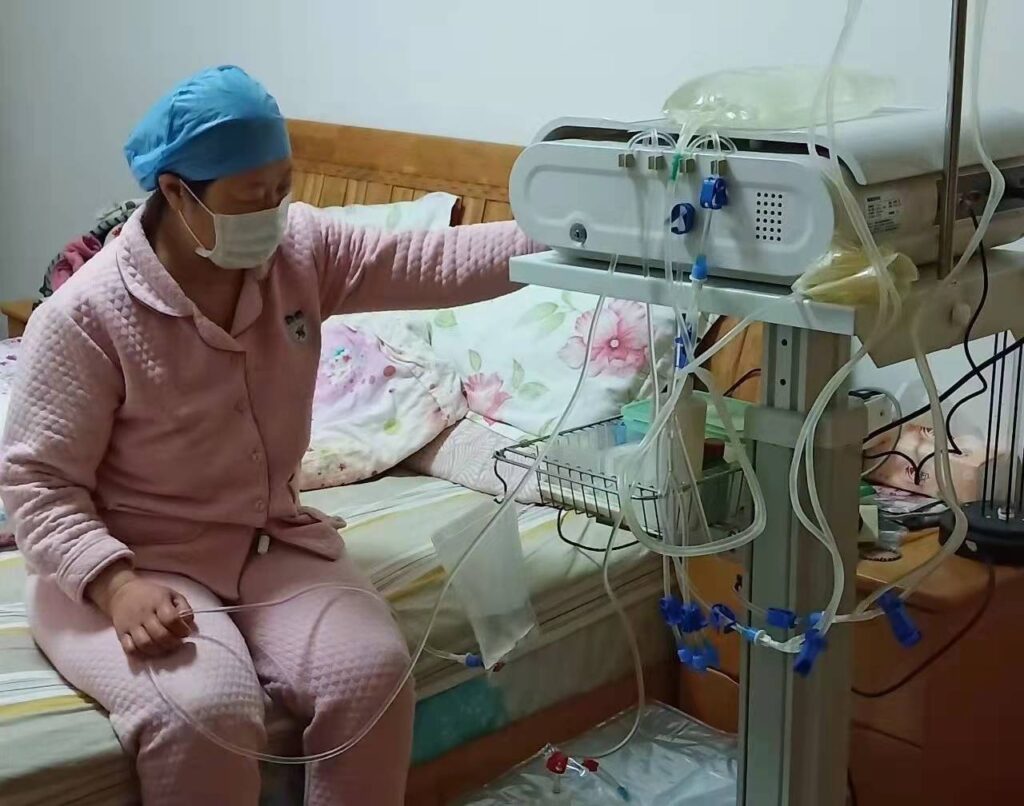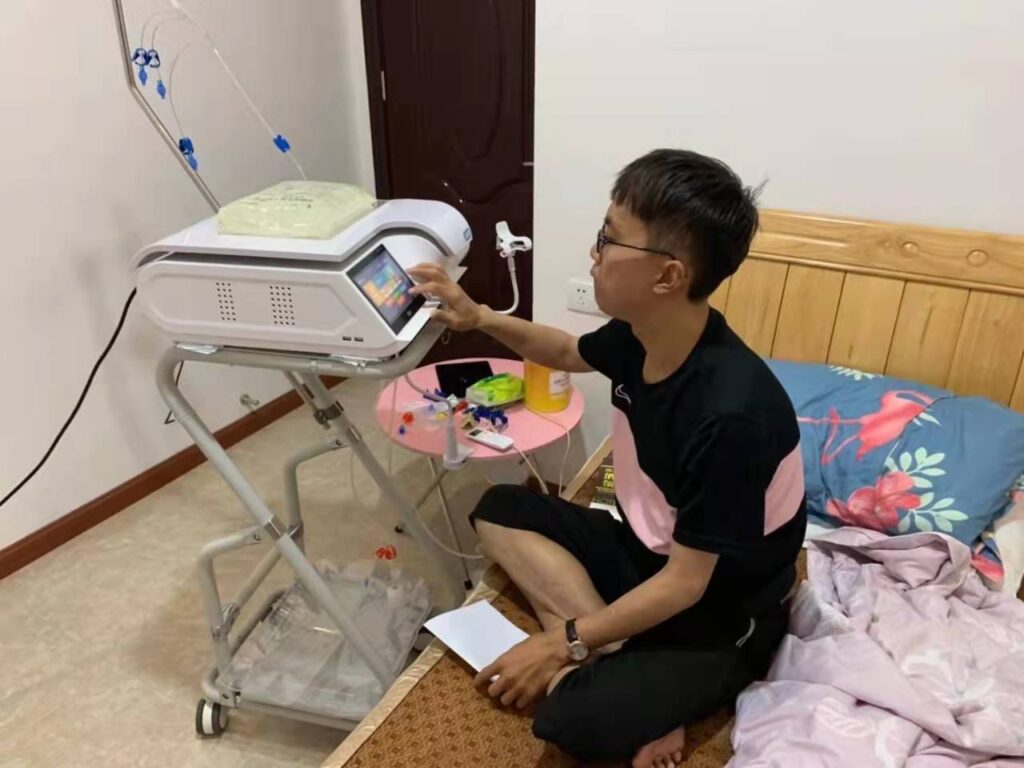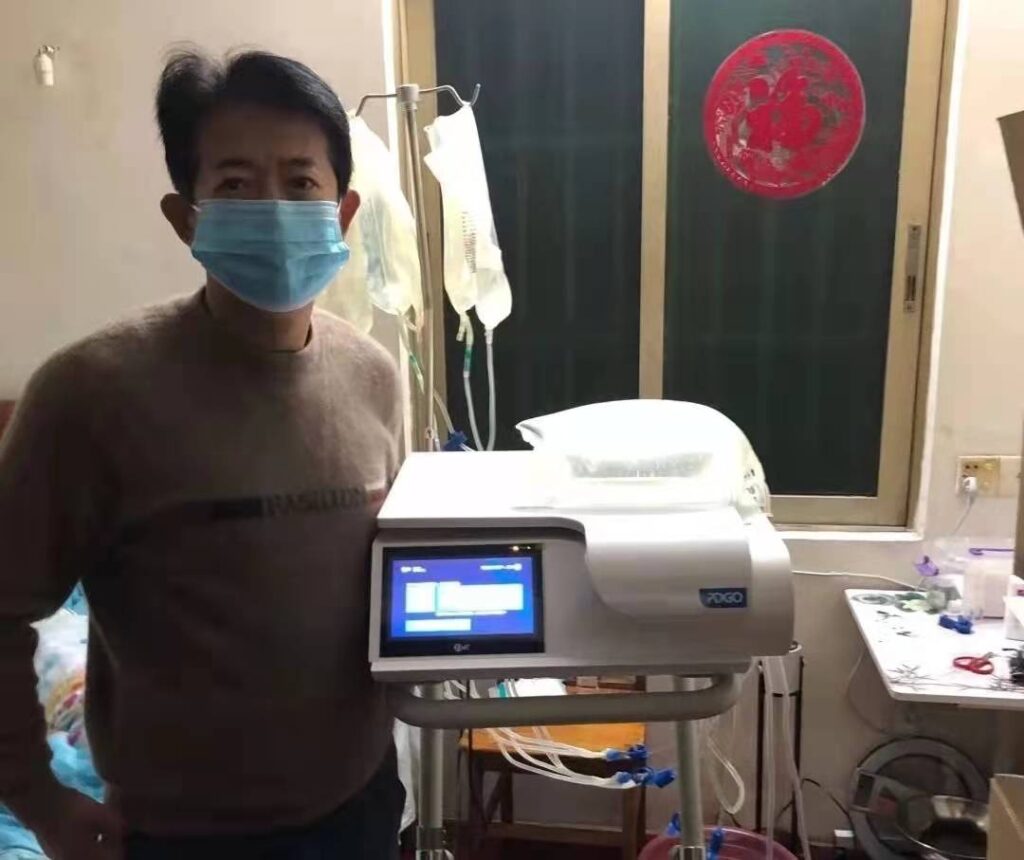Introduction
Peritoneal dialysis is a common blood purification method, mainly used to treat chronic renal failure. It injects dialysate into the abdominal cavity, uses the peritoneum as a semipermeable membrane, and allows excess water, electrolytes and metabolic waste in the body to be discharged from the body through the dialysate, thereby achieving the purpose of purifying the blood.
Compared with traditional hemodialysis, peritoneal dialysis that can be performed at home has now been chosen by more and more patients. According to doctors, hemodialysis requires patients to go to the hospital to ask medical staff to help complete it. The entire dialysis time is 4 to 5 hours, 2 to 3 times a week, which causes chronic kidney disease patients to basically be out of society. For peritoneal dialysis, after receiving training from medical staff, patients can take a month’s worth of peritoneal dialysis fluid at the hospital at one time and perform it at home. Previously, the peritoneal dialysis fluid was changed every 4 to 6 hours, and each change took about 20 minutes, and 3 to 4 changes a day; after purchasing a home dialysis machine, the number of dialysis sessions was reduced to 1, and synchronous dialysis can be achieved while sleeping. Peritoneal dialysis allows patients to work and live normally.
If you think the price of Fresenius Medical Care’s dialysis machine is too expensive, you might as well consider our CNMEDITECH peritoneal dialysis machine.
If you do home peritoneal dialysis, you can choose to do automated, longer treatments using a PD machine or do manual treatments that use gravity and simple equipment rather than electricity. In addition to your PD machine, other costs that may be covered include dialysate solution and medical supplies.
How does peritoneal dialysis work?
Before starting peritoneal dialysis, a safe passage must be established for fluid exchange. Therefore, patients need to go to the hospital for an abdominal surgery to insert a peritoneal tube into the abdominal cavity. This tube is called a peritoneal dialysis tube. One end of the tube remains in the abdominal cavity, the middle section is buried under the skin, and the other end remains outside the abdominal wall. Before discharge, patients will receive specific training, and there will be special doctors and nurses to teach you how to perform peritoneal dialysis.
When patients are at home, they need to connect special dialysis fluid pipes to each other, pour the dialysis fluid into the abdominal cavity, and keep it for a period of time to allow the fresh dialysis fluid and the excess or harmful components in the blood to fully exchange. At this time, the peritoneum acts like a sieve to remove excess water and toxins from the body into the dialysis fluid in the abdominal cavity.
Then release the dialysis fluid containing toxins through the peritoneal dialysis tube, and then pour in new dialysis fluid, and continue to circulate, and finally achieve the effect of peritoneal dialysis. The real principle of peritoneal dialysis is that the peritoneum is a semipermeable membrane with a large area and rich capillaries. During peritoneal dialysis, the blood in the peritoneal capillary cavity immersed in the dialysate undergoes extensive material exchange with the dialysate to remove metabolites and toxins in the body and correct water, electrolyte, and acid-base imbalances. In peritoneal dialysis, the main way for solutes to exchange substances is diffusion and convection, and the removal of water mainly relies on ultrafiltration by increasing osmotic pressure.

What are the advantages of ADP compared to traditional peritoneal dialysis?
①The biggest advantage of automated peritoneal dialysis is that it uses machinery to complete the exchange of dialysate during peritoneal dialysis. It is simple to operate and can be performed at home by patients. It can be performed when patients rest at night, which has little impact on daytime work. It is significantly better than traditional peritoneal dialysis in adjusting the patient’s social role and reducing mental stress;
②Automated peritoneal dialysis reduces a large number of manual operations during dialysis, reduces the chance of abdominal contamination, and has a lower incidence of peritonitis than traditional peritoneal dialysis;
③ADP can more flexibly adjust the frequency and amount of dialysate infusion of peritoneal dialysis to achieve better toxin and water removal effects.
Therefore, for patients who need to work normally or need help from others during the day, automated peritoneal dialysis is more suitable than traditional peritoneal dialysis, such as patients who need to go to school or work, children with high abdominal transport, elderly patients with mobility problems or visual impairment, and those with psychological problems caused by abdominal distension.
Which patients are suitable for peritoneal dialysis?
First of all, there is no doubt that patients with acute kidney injury and chronic renal failure should undergo peritoneal dialysis in a timely manner.
Secondly, many people actually want to know how to choose between hemodialysis and peritoneal dialysis?
①Because peritoneal dialysis does not require special equipment, has little effect on hemodynamics, has little effect on residual renal function, and does not require anticoagulation, it can be given priority for certain patients with chronic renal failure, such as infants and children, those with unstable circulatory function, obvious bleeding or bleeding tendency, good residual renal function, poor vascular conditions or repeated arteriovenous fistula failures, and hemodialysis patients with repeated and severe dialysis-related symptoms.
②For some toxic diseases, water and electrolyte imbalance, congestive heart failure, etc., if there are no hemodialysis conditions, peritoneal dialysis can also be considered.
③Patients who prefer home treatment and have difficulty in going to the hospital for hemodialysis.
④Hemodialysis is to directly draw blood out of the body for dialysis, so the patient’s blood pressure often fluctuates during the dialysis process. Therefore, peritoneal dialysis is more suitable for patients with hypertension, heart disease, etc. who need strict blood pressure control; in addition, diabetic patients have hardened blood vessels, fragile tube walls, and lack of elasticity, which are also more suitable for peritoneal dialysis.

Which patients cannot undergo peritoneal dialysis?
①Various abdominal lesions lead to reduced peritoneal clearance, such as chronic persistent or recurrent abdominal infection, or extensive peritoneal metastasis of intra-abdominal tumors leading to extensive peritoneal fibrosis and adhesion in patients, reduced dialysis area, affecting the flow of fluid in the abdominal cavity, weakening or losing the ultrafiltration function of the peritoneum, and reducing the transport efficiency of solutes.
②Patients with severe skin diseases, extensive abdominal wall infection, or large-area burns in the abdomen who do not have a suitable location for peritoneal dialysis catheter insertion.
③Within 3 days of abdominal surgery, if the wound has not healed, the incision leaks during peritoneal dialysis;
④There are localized inflammatory lesions in the peritoneum, and peritoneal dialysis can spread the inflammation;
⑤In late pregnancy or huge tumors in the abdominal cavity, the peritoneal dialysis effect is not ideal due to the reduction of the abdominal cavity volume;
⑥Intra-abdominal vascular diseases, such as multiple vasculitis, severe arteriosclerosis, scleroderma, etc., will reduce the efficiency of dialysis;
⑦Severe obesity, due to severe obesity, the subcutaneous tissue is very thick, making it difficult to implant the dialysis tube, and the dialysis fluid is prone to leakage;
⑧People with long-term insufficient protein and calorie intake should not undergo long-term chronic peritoneal dialysis, because peritoneal dialysis loses more than 6g of protein per day.
What are the advantages and disadvantages of peritoneal dialysis?
Advantages
①Peritoneal dialysis is a continuous treatment every day, the body’s metabolic balance is in a relatively stable state, and the impact on the cardiovascular system is relatively small.
②Peritoneal dialysis is better for maintaining residual renal function.
③Peritoneal dialysis does not require special equipment, is easy to operate and is inexpensive. It is a good way of home dialysis, especially for patients in remote rural areas.
④No need for vascular puncture, avoiding puncture pain.
⑤The chance of hepatitis infection (hepatitis C, hepatitis B) is low.
⑥Peritoneal dialysis does not require extracorporeal circulation, and has little effect on anemia.
Disadvantages
①If the operation is improper, peritonitis is prone to occur, which is the most common complication of peritoneal dialysis.
②Due to home treatment, the living environment is required to be relatively good and clean.
③A certain amount of space is needed at home to store peritoneal dialysis items and perform fluid exchange operations.

What complications may occur with peritoneal dialysis?
①Peritonitis and catheter-related infection: Peritoneal dialysis requires the dialysis fluid to be poured into the abdominal cavity. If the surrounding environment is not clean and the aseptic operation is improper, it may cause infection in the abdominal cavity or around the catheter. If infection occurs, peritoneal dialysis should be stopped immediately and antibiotics should be used for treatment;
②Early complications related to dialysis catheterization, such as bleeding, leakage, dialysis tube obstruction, displacement, pain, etc.;
③Non-infectious complications related to dialysis, such as hernia at the catheter outlet, peritoneal dialysis fluid leakage, pleural effusion, back pain, etc.
How to care for peritoneal dialysis patients in daily life?
Peritoneal dialysis is very convenient and can be performed at home, but if it is not properly cared for in daily life, the probability of complications will be greatly increased, and the effect of dialysis will be greatly discounted. Therefore, peritoneal dialysis patients should pay attention to the following points in their daily life:
①Before changing the peritoneal dialysis fluid, ensure that the environment is clean, wash your hands, wear a mask, and strictly operate aseptically. Under normal circumstances, the skin at the catheter outlet is disinfected, cleaned and cared for once every 2 days. If there is infection or scab, it should be cared for once a day, and the iodine cap should be used once.
②Accurately record the dialysate input and drainage volume, and observe the color and clarity of the effluent. If you encounter symptoms such as poor drainage, abdominal distension, and abdominal pain, you should seek medical attention immediately and deal with it in time.
③Peritoneal dialysis will take away excess water and toxins such as creatinine and urea nitrogen, as well as some proteins, vitamins and other substances that are beneficial to the human body. If the loss of nutrients is not serious, it can be supplemented through diet. At the same time, it is also necessary to pay attention to the restriction of intake of some foods that may aggravate the condition. Peritoneal dialysis patients should usually eat more high-quality animal protein, foods rich in vitamins B and C, and foods rich in fiber. However, you should eat less high-phosphorus foods and reduce salt intake to prevent excessive fluid load.
④Peritoneal dialysis patients should be followed up regularly after discharge according to their condition and treatment needs. Patients who have just started peritoneal dialysis treatment should return to the hospital for the first follow-up 2-4 weeks after discharge to complete the peritoneal balance test and evaluate the adequacy of dialysis. It is recommended to check once every 6 months. Those with unstable or changing conditions should follow up or be hospitalized at any time. If a patient’s condition suddenly changes, they can contact the specialized nurses and doctors at the peritoneal dialysis center by phone and receive remote guidance.
Why Choose Us?

CNMEDITECH is dedicated to the long-term research of the medical consumables market. Our mission is “People oriented and win-win strategy,Matching the real needs of the region with a focus on human health,To be the world’s first-class medical field solution expert”. We have been manufacturing high-quality medical device products for more than ten years.
We have built our reputation on delivering quality healthcare solutions on time and on budget. All our products comply with international health and safety regulations and all products come with a warranty.
Are you still worrying about your customer’s product needs? Are you still angry that the product is expensive?Our medical consumables support personalized product customization.
Our company has many styles to choose from. In addition, we have high-quality pre-sales consulting guidance and professional after-sales service, all to meet your needs.
Whether it is a cost-effective or high-end product, there will always be something suitable for you. If you have any needs for products, you can ask us, our factory will meet your needs as soon as possible, and we will make every effort to provide you with solutions.Feel free to send us your inquiries.








